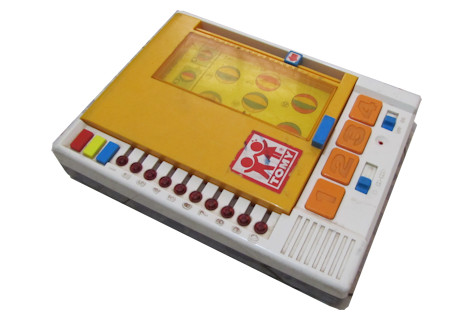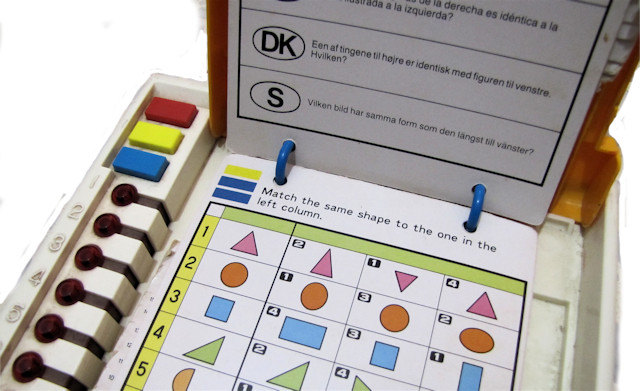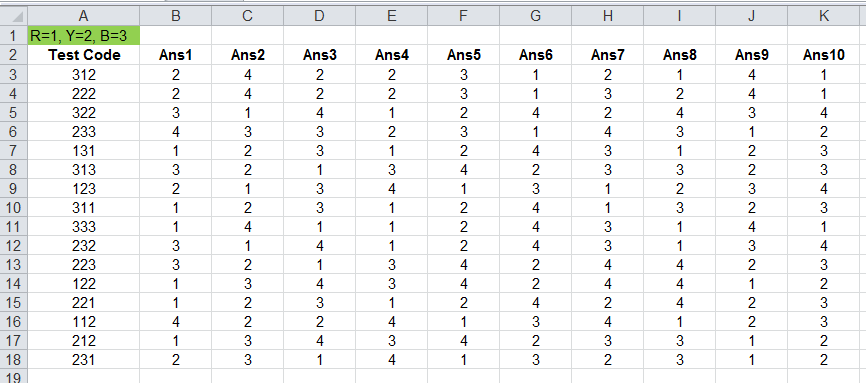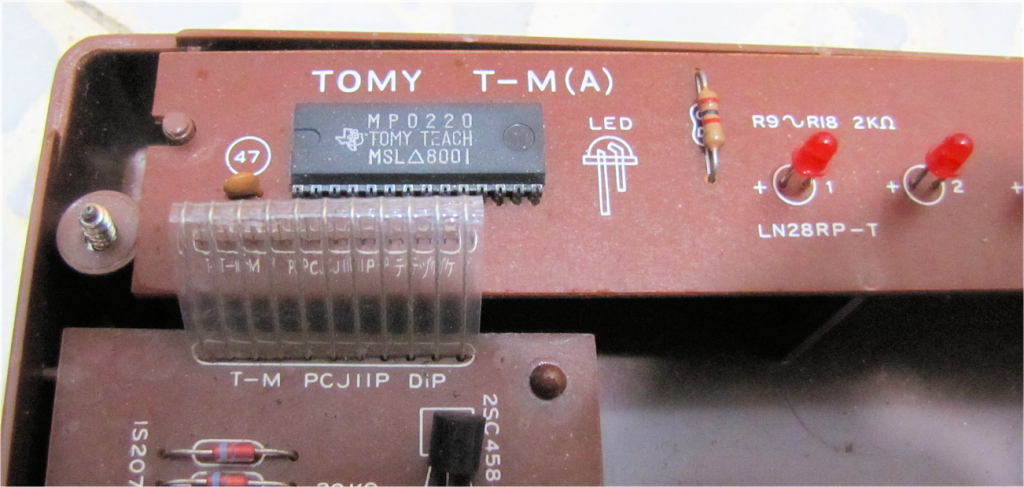Back in the early 80’s, children around the world spent endless hours solving multiple-choice quizzes on an electronic toy called “TOMY Teacher” (AKA “Sears Quiz-A-Tron”). In those days, bytes weren’t cheap; so how did this device remember all the solutions to all of its quizzes?

The Game
This ancient game is made up of two parts: the electronic device (with buttons, LEDs and a speaker), and printed notebooks with quiz cards. The user puts a notebook in the device, selects a quiz, and presses the color buttons to input the quiz color code that’s printed on the card. This tells the device which quiz was selected and, therefore, what the correct answers are. The user then selected answers to the ten questions, using the 1-4 buttons, and if there were no mistakes, the LEDs flashed and a primitive happy music played. It was glorious.

Precalculated?
Let’s do some math. The quiz code is always three parts long, and there are three colors to choose from, so there are only 3^3 = 27 possible codes. Each quiz has ten answers, and each of those occupies – if handled economically – two bits. Overall, that’s 68 bytes. Not too much even in 1980; A well-randomized answer key could be saved on some ROM chip.
Since my kids are still playing with this old unit, I didn’t want to open it up and risk damage; who knows what thin threads of rust are holding its components together now! But I suspected that the answers were not actually stored anywhere, because it was probably cheaper, thirty-five years ago, to generate them on the fly.
The Quest Begins
So I fired up Excel, assigned digits to the code colors (Red=1, Yellow=2, Blue=3), and painstakingly wrote down the codes and the correct answers to a sample of 16 different quizzes. Then, Zen-like, I gazed at the numbers and waited for an enlightenment to come.

Almost immediately, I noticed a few repeating sequences. For instance, the first six answers for quiz 312 and quiz 222 are identical. For me, this was proof enough that the sequences were indeed generated; no one would have put such blatant repetitions in a truly randomized data table.
Zen only took me this far, though, so I turned to more “western” ways of thinking: what would a 1980 electronic circuit designer do to create sequences of pseudo-random numbers? I calculated the sum of each codes’ digits (e.g. 312 is 3+1+2 = 6), and took the remainder from dividing by 4 (because there are only 4 possible answers). Bingo! When replacing the 0’s with 4’s, the results of this calculation matched the correct answers to question #1 in all quizzes!
Keep Adding Up
Okay, but what about the other nine answers? After pursuing a few small red herrings, I decided to look not at the raw numbers, but at the differences between consecutive answers. Why? Because if the first answer is a result of some accumulation process, the following answers probably result from the same kind of process, and the differences will help me see what’s being added on each step.
BAM! The moment I created the “difference” columns, I could clearly see that answer #5 was always answer #4 plus one (again, taking the remainder), answer #6 was always #5 plus two, and #10 was always #9 plus one. Awesome. Now, what about the remaining six columns, where the difference was not uniform?
A careful examination revealed that on three of these columns, the numbers ranged only from 1 to 3, and did not include the perfectly legitimate zero difference. Gee, I wonder where we can possibly find three different pseudo-random numbers ranging from 1 to 3! And indeed, the difference between answer #2 and #1 is the last digit of the quiz code, answer #7 is #6 plus the middle digit of the code, and #9 is #8 plus the first digit.
Three down, three to go. These I solved fast, because I’ve already got the hang of this game: they were exact duplication of previous answers. Answer #3 was #2 plus #1 (which also happens to be the code digit sum), Answer #4 was #3 plus #2, and Answer #8 was #7 plus #5.
So, to summarize, the running sum that provides the answer sequence for each quiz is:
Answer[1 to 10] = Sum + Last Digit + Answer[1] + Answer[2] + 1 + 2 + Middle Digit + Answer[5] + First Digit + 1
I ran this model on two new quizzes, which were not included in the original sample, and the answers came out perfect.
Now What?
I broke the code, but I still don’t understand it. Given that the toy plays “music”, I assumed there’s some sort of processor in there, not just simple logic ICs; but from a low-level programming perspective, it’s not obvious why anyone would choose this exact sequence of additions. Was it obfuscated intentionally, to prevent casual curious cats from figuring out the sequence (remember there was no Excel in 1980)? Is there something in the architecture of the specific processor that makes calculating this sequence really economical, in terms of assembly instructions and memory?
[Addendum] Well, I couldn’t resist the urge and opened the toy up. There was indeed only a single IC there, made by TI but marked with some TOMY code that I couldn’t find on the internet. I didn’t even find TI MCUs from that era that could be it.

I turned to TOMY’s customer service, asking whether they have some information or contact I can consult regarding this mystery. Unfortunately, they said they didn’t.
So, what do you think? Is there anyone still out there with more information?

Awesome article. Really enjoyed your reverse engineering 🙂
Had this toy as a kid, and it was pure fun playing with it.
Now for the real question, where can I buy this toy? Lol
Thanks. Maybe there are still some available on ebay, or some retro games forum/group…
Just leaving a (from Neptunes suggestion) reference manual to the TMS1000 chip set here: http://en.wikichip.org/w/images/f/ff/TMS1000_Series_Programmer%27s_reference_manual.pdf
Thanks! More information that I’m willing to invest in for this little inquiry… but it’ll probably come in handy sometime.
Hello. In the Excel spreadsheet is not visible, and a surplus for the first question, if the color code of red, red, red (1 + 1 + 1). Then the sum of 3, how to calculate the remainder of division by 4?
I don’t know if I’m using the correct math terminology in English… basically, divide the number by 4 using whole numbers only (if the number is 3, the result is therefore 0) and the remainder is what’s left: 3.
If you have, say, 3+3, then the “regular” result is 6; divide that by 4 to get 1, with 2 left over.
Totally understandable. Another term for the “remainder after division” is “modulus”.
I thought it was used only in programming context… which most readers here will probably be familiar with. Hmmm.
Do I understand correctly that if the number of red-red-red, the correct answer to question 1 – 3 button?
Yes, the code red/red/red translates to 1/1/1, so the sum is 3 and that’s the answer for question 1.
The answer to Question 2 is the previous answer + the last digit (which is 1), so it’s 4,
etc.
Thank you. Sorry, English is not my native language
Neither is mine 🙂
Likely a 4-bit microcontroller from the TMS1000 family with custom ROM. Has the same DIP28 package. Google reveals that Tomy used these micros in other games in the early 80s with similar MPxxxx part numbers.
Thanks! This didn’t come up on my searches… now I have a whole new thing to explore 🙂
it is most likely like the Eproms in Ford OBD 1 computers. even though they were made by Intel, there are no datasheets for them
In this case though, it turned out to be a pretty famous chip – just hidden under a TOMY code. I guess that back then, there simply weren’t many microcontrollers to choose from!